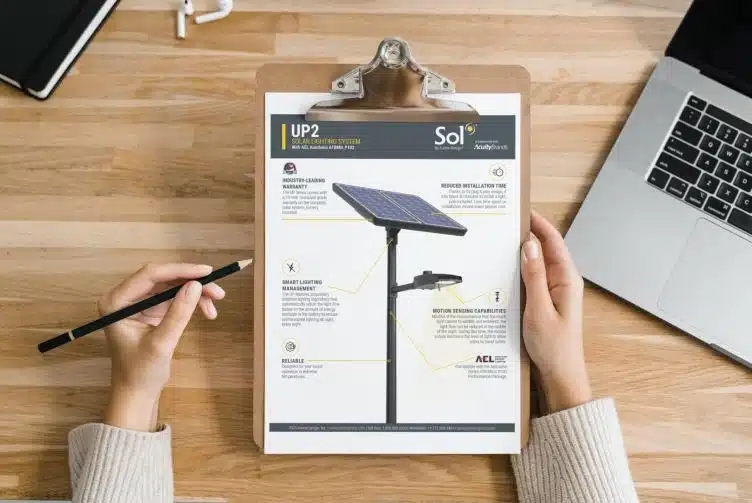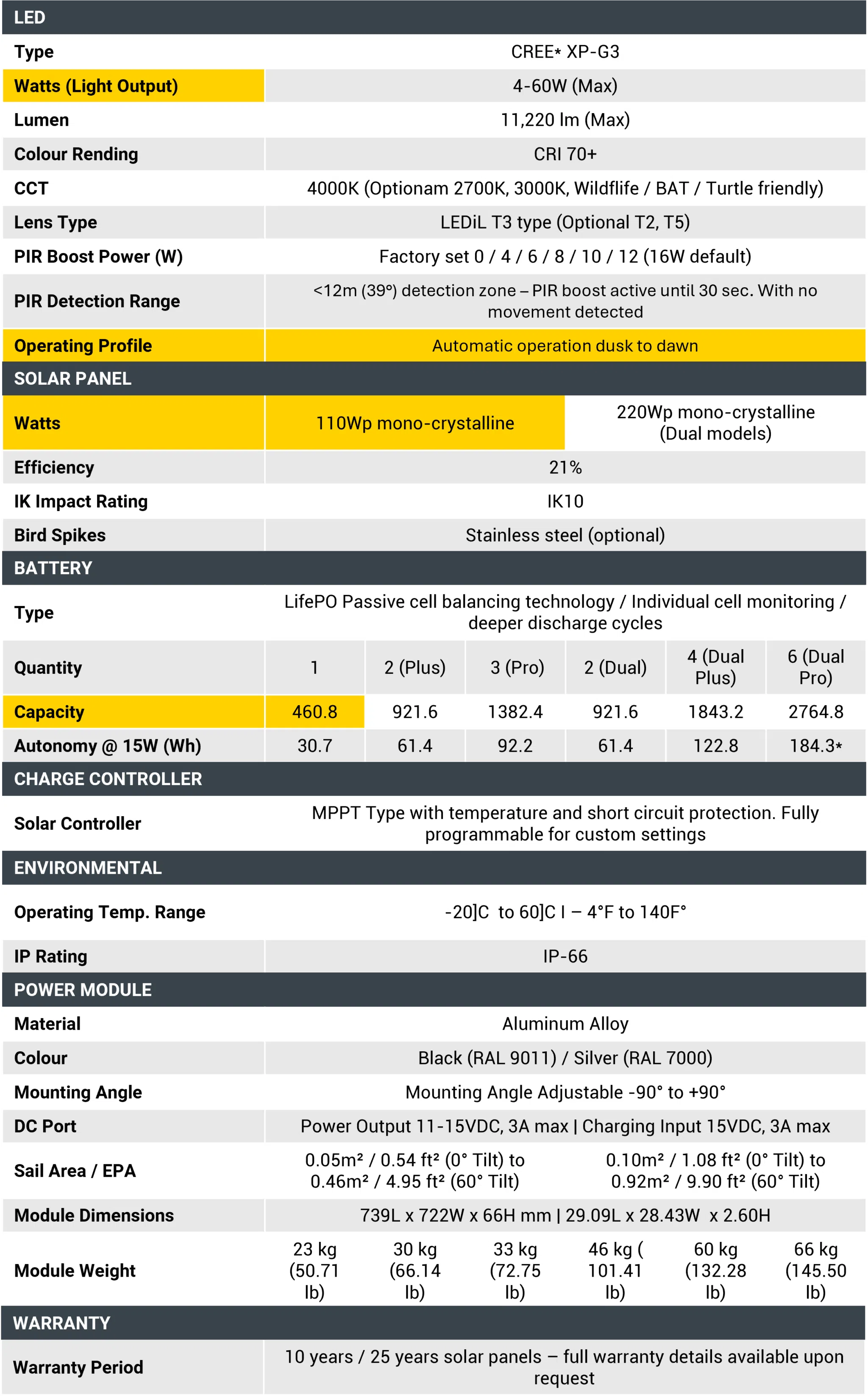If you're planning to use solar lighting for your next project, you're on the right track. But choosing the right product and manufacturer can be a bit of a challenge. Unlike other consumer products like air fryers or smartwatches, there's no go-to resource like Wirecutter or CNET for solar lighting. Instead, you'll often find yourself relying on spec sheets.  What is a spec sheet? It's a detailed document that provides all the technical information needed to compare different solar lighting products. These sheets are essential but can be confusing if you don’t know how to interpret them. Understanding the numbers, acronyms, and what they mean is crucial to making an informed decision.  Spec sheets contain a wealth of information, but not all of it is relevant to your specific needs. To ensure a product will work for your project, focus on four key metrics: the solar panel size (Wp), the fixture output (W), battery capacity (Wh), and the system’s operating profile or run-time. These are the most important factors in determining whether the system will meet your energy requirements.   While spec sheets are full of technical details, you don't need to understand everything to make a good decision. The four main points mentioned above should guide your evaluation. However, be cautious—some manufacturers may omit certain details to hide weaknesses in their products. If a company doesn’t provide clear data, it could be a red flag.  Here’s an example of a well-documented spec sheet with the necessary information highlighted:   With this data, you can perform simple calculations to determine if the system will meet your energy needs. This helps avoid overpaying for features you don’t need or underestimating your power requirements.   To determine the right solar panel size, start by finding the average peak sun hours in your area during the worst month. Use tools like NREL’s PVWatts Calculator to get accurate data. For example, in Charlotte, NC, the average is around 3.73 peak sun hours in December.  Calculate the daily charging capacity by multiplying the peak sun hours by the panel’s watt-peak (Wp). For a 110Wp panel, that would be 410Wh. But remember, this is the maximum. In real-world conditions, you’ll likely get less due to weather, dust, and other factors.  To account for these variations, apply an array-to-load ratio (ALR) of 1.2:1. This ensures the system can recover from low-energy days. Using the same example, 410Wh / 1.2 = 341Wh. This is the effective daily load the system can handle.  Some manufacturers also use derating factors to adjust for real-world performance. Be sure to ask about this when evaluating products. A system without proper derating may not deliver as promised.   Next, calculate how much energy your fixture will consume. Use NOAA’s Solar Calculator to find the longest night in your area. For Charlotte, it’s 14 hours. Then, check the fixture’s output (in watts) and multiply it by the number of hours to get the daily load.  For instance, a 30W fixture running for 14 hours would require 420Wh. If the available energy (341Wh) is less than the required load, you may need to reduce the output or adjust the operating profile.  A 4D1 profile, which dims the light in the middle of the night, can help reduce energy consumption. This type of schedule allows the system to function efficiently even with limited solar input.  Understanding your operating profile is key to designing a sustainable solar lighting system. It allows you to balance performance with energy efficiency.   Batteries are critical for ensuring your system works reliably, especially on cloudy days or during long nights. Different battery chemistries offer varying levels of performance and lifespan. Lead-acid batteries have lower discharge rates, while lithium batteries can be discharged more deeply without significant damage.  To determine the minimum battery capacity, multiply the daily load by two (for two full nights of operation). Then, adjust for depth of discharge (DOD). For lithium batteries, divide by 0.7 to account for safe discharge limits.  Using our example, 285Wh x 2 = 570Wh, and 570Wh / 0.7 = 814Wh. This means you’d need at least two batteries to meet the requirement. Always check the DOD specifications provided by the manufacturer to ensure the system can last as long as expected.   In addition to sizing, pay attention to other factors such as warranty, certifications, and fixture quality. Warranties can protect your investment, while certifications ensure safety and reliability. High-quality fixtures from trusted manufacturers like Acuity Brands offer better performance and longevity.   Most solar lighting systems come with a warranty, but the terms vary. Some cover only the system, while others include the battery. A full 10-year warranty is a strong indicator of quality and confidence from the manufacturer.   Certifications from organizations like IEC and IEEE add credibility to a product. They ensure compliance with industry standards and verify performance claims. LM-79 testing is particularly important as it measures the actual output and efficacy of the entire fixture, not just individual components.   Finally, consider the quality and origin of the fixture itself. Whether the manufacturer builds its own fixtures or uses third-party components can impact performance. Reputable brands like Acuity Brands have a proven track record of delivering reliable, high-quality solar lighting solutions.   Reading and understanding solar lighting spec sheets might seem overwhelming, but with the right knowledge, it becomes manageable. Focus on the key metrics, do the math, and always ask questions. This approach will help you choose the best product for your project, saving time, money, and potential headaches down the road.  If you have any questions about spec sheets or anything else related to solar lighting, feel free to reach out. Our team of experts is here to help you make the right choice.  Actmix Deodorant series chemicals, can effectively inhibit and absorb the pungent smell and other peculiar smell of various chemicals, and also absorb the residue of harmful volatile components, such as benzene, ammonia, formaldehyde, chlorine etc. Meanwhile it can effectively reduce the VOC content in the product. It has excellent compatibility to all kinds of rubber and has the characteristics of long aging, small amount of addition and shows no impact to the performance of the medium which needed to cover and absorb, as it`s made of natural inorganic silicate, non-toxic and harmless, green environmental protection. Rubber Deodorant, Environmental-Friendly Rubber Chemicals, Inorganic Silicate Ningbo Actmix Rubber Chemicals Co.,Ltd. , https://www.predispersedchemical.comThe info you actually need
Solar panel collection
Fixture output and operating profile
Battery capacity and chemistry
Other considerations
Warranty
Certifications and testing standards
Fixture characteristics
Wrapping up
Contact us

